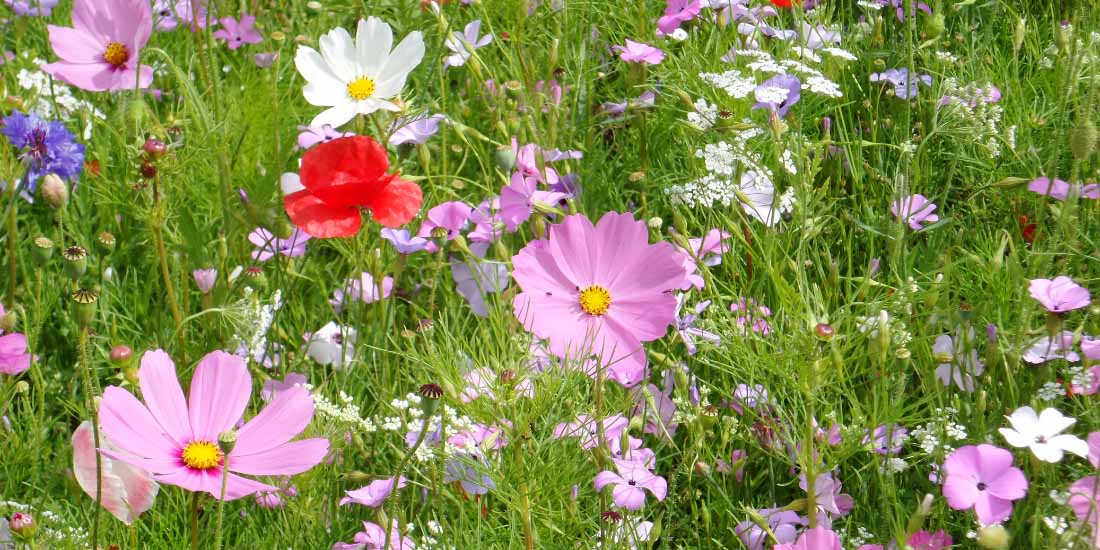How to prepare a wildflower seedbed

Knowing how to prepare a wildflower seedbed properly will increase the growth of your wildflowers and will ensure they each have enough space to grow. It also helps your wildflowers get their even share of air, water and sunlight to thrive as best they can throughout the season.
Choose the perfect wildflower seed mix for your garden
Before you begin any prep work in the garden, it helps to know what wildflowers to choose and see blooming in your garden. Consider whether you want a wildflower meadow that benefits bees and other pollinators or an ornamental display of beautiful flowers that shows for one year only.
Keep reading for detailed but easy-to-follow advice on how to prepare a wildflower seedbed!
Thinking about what ‘type’ of wildflower mix you want will make things easier. For example, We also have wildflower mixes that are 100% wildflower, with no grasses, which are premium wildflower mixtures that are bees and pollinators approved. We also have wildflower seed mixes that include meadow grasses to create a sustainable habitat for local wildlife and will help prevent weeds from growing.
So, if you want to create a year-round habitat for bees, pollinators and local wildlife or have an area where you want to plant wildflowers to keep weeds away, then a seed mix with grass is your best option. However, if you want to plant wildflowers to create a colourful, sweet-smelling mix in a flower bed, rock garden or planter that you would like to swap out every year, then a seed mix with 100% wildflowers is what you need.
We also have a guide about the differences between annual and perennial wildflowers.
Know when to sow your seed
Now that you’ve picked your seed, you are getting closer to preparing your wildflower seedbed. But the last step in our how to prepare a wildflower seedbed guide is to check the weather! Wildflowers differ from grass because they don’t require a specific temperature to germinate and grow. So, knowing when to sow may not seem as important, but it does determine when they will bloom!
The sowing season for wildflowers is generally from March to October, and the wildflowers bloom 60-80 days after they’ve been sown. Sowing in early spring (between March and April) will provide a showing of the annual wildflower in your mix in summer. And if you decide to sow in early autumn (from September to October), you will see your flowers blooming in early spring.
The best turnaround is to sow your wildflowers in early autumn to have them bloom the following spring.
Preparing a wildflower seedbed
For this step in preparing a wildflower seedbed, you only need a few common garden tools: a garden trowel, a garden fork, a rake, a watering can and your wildflower seed. Follow our easy steps below for how to prepare a wildflower seedbed:
- First, we recommend you remove any existing grass, weeds and flowers from the area you will be sowing your wildflower seed
- Then remove the top 5-10cm of soil to reduce soil fertility
- You can then leave this area to cultivate for a few weeds and remove any weeds that pop up to the surface during this time
- During this time, do not add topsoil, compost or fertiliser because wildflowers prefer low-nutrient growing conditions
- After the cultivation (and when nothing else is showing signs of growth), remove stones, rocks and any other debris
- And rake the soil to create a fine, easily crumbled and level seedbed
- Then scatter the wildflower seed at a rate of 5g per m2
- Rake the seed so it’s sitting amongst the soil
- And then water the entire area where you have sown the seed well
If you are sowing the seed in dry conditions, we recommend you water the area to keep it moist for the first six weeks.
Aftercare for your freshly prepared wildflower seedbed
If you have sown your wildflower seed in April/May (spring)
In August/September, in the first year since you sowed your wildflower seed, you want to cut your wildflower down to 7cm tall after the blooming period has ended.
This is easily done by putting your mower on its highest setting and, in most cases, removing the clippings* afterwards.
*If you have annual wildflowers in your mix and would like them to return the following year, you can do this by allowing the flowers to go to seed head.
Then, manually assist their self-seeding by firming the seed heads directly into the soil. By doing this, your annual wildflowers will return the following year.
Do not be tempted to add topsoil or fertiliser to the area where the wildflowers are growing. Wildflowers grow better in poor soil conditions, so simply continue this process year after year for diminishing returns.
If you sowed your wildflower seed in September/October (autumn)
In March/April of the first year of sowing your seed, ensure there’s enough growth height to mow – your wildflowers must be at least 10cm high. If your wildflowers are this tall, mow them down to 7cm, no later than mid-April, delaying the blooming process. Then, by August/September, after they bloomed, you can cut your meadow back to 7cm and remove your clippings unless you want your annuals to return the following year.
Reseeding at this time of year is the same as before; allow your wildflowers to reach that seed head and manually firm the seed heads into the earth.
If you have any questions on this process or have queries that may seem unique to your garden, please get in touch, and we will be happy to help.